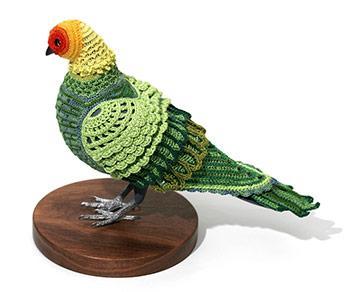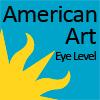Debrah Dunner, curatorial assistant at our Renwick Gallery, interviewed Laurel Roth, a featured artist in the 40 Under 40: Craft Futures exhibition, now on view at the Renwick Gallery through February 3, 2013.
We are currently running a campaign to acquire Laurel's birds Martha and Incas from her series "Biodiversity Reclamation Suits". Help us give Martha and Incas a permanent home here at the museum by donating to our micro-donations campaign.

Laurel Roth's Carolina Parakeet
Eye Level: You have no formal art training, tell us how you came into the field.
Laurel Roth: Like many people, I’ve always had the need to make things with my hands and imagination, but growing up in a single-parent, lower working class rural home I felt that my creative urges and love of drawing and making were somewhat impractical indulgences. Practicality tends to be necessary for independence and survival, so I didn’t really allow myself to imagine life as an artist until I was in my thirties and had been working a variety of mostly blue-collar jobs since I was 15.
I was a park ranger when I met my partner, Andy Diaz Hope, and moved to San Francisco. Being a bit of a country girl, I felt rather lost in my new urban environment. I started building little animals from urban detritus to inspire me to adapt myself to my new surroundings. I’d sculpt a tiny bird from a packing peanut, a cigarette butt, and burned out matches to act as a role model for me to learn to make use of the nutrients and systems of my new surroundings. It was playing, really, but it opened up a whole world of thinking and making for me that I just dove into. Sculpture quickly became a way for me to learn, think about, and make peace with the world. Andy is also an artist and has been supportive and encouraging, which helped me to find confidence along the way.
I used to be self conscious about not having a college education, but I think that, in the long run, it serves me just fine to have developed my own path and voice, and I feel very lucky to have the career that I do.
EL: Where did your idea for the biodiversity reclamation suits come from?
LR: With this series I wanted to address the feelings of helplessness and confused shame that come with learning about accelerated extinction rates caused by humans. It’s such an overwhelming topic that I needed to tackle it with humor and hope, however blind or tongue-in-cheek. Visually recreating lost bio-diversity by using the rarely appreciated but highly adaptable pigeon serves both to highlight the loss that we have already sustained while drawing attention to the fact that we often revile the animals most capable of living in a human made environment. An extinct or endangered animal is precious to us due to its scarcity, and its scarcity is due to its inability to adapt to the way we change the world. Pigeons, on the other hand, adapt to us amazing well (along with rats, roaches, etc) and are often despised.
EL: Do you think your objective is achieved through the suits?
LR: I think so. Each person has their own reactions to any art, but the responses I’ve read and heard to the Biodiversity Suits lead me to feel that many people get the subtleties of what I want to communicate through them.
EL: What are some of the other subjects your work revolves around?
LR: The years I spent doing natural resource conservation and being a park ranger led me to a role of mediation between the environment and society, and I think that’s what I’m still exploring with my sculpture. How the two merge and affect each other fascinates me.
EL: Many of the materials you use are readily available and can be found in the local corner store. What drew you to use such mass produced items for your art work?
LR: That goes back to the idea of ecological systems. I try to look at human systems from an ecological standpoint so that I might understand them better. Some of my early work used recycled material in order to mimic nutrient recycling. I started looking at fake fingernails and beauty products as a sort of mating plumage. I want to make work that is accessible to people outside the fine art world, and using mass produced materials can be part of that.
EL: What are you working on now?
LR: Last week I finished two carved wood hominid skulls – one spalted maple mountain gorilla and one walnut chimpanzee – for Schroeder Romero Gallery to bring to the Pulse Art Fair in Miami. Now I’m working towards my solo exhibition next September, tentatively titled “Flight of the Dodo,” at Gallery Wendi Norris in San Francisco. I’m taking some pieces in the show to a new level of complexity, which I’m really excited about. There will be a few pieces each from different series I’ve been working on tied together and displayed along the layout of a gothic nave.
I also recently finished a collaborative tapestry with Andy Diaz Hope that we worked on together during an artist fellowship with the de Young Museum in San Francisco. We’ll be displaying it at the museum in March of 2013 as part of a triptych it completes titled The Conflicts, and are organizing some lectures and demonstrations along with the exhibition.

